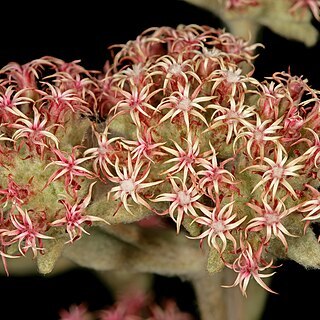Perennial herb, up to 300 mm high; erect or decumbent and then erect, simple or branched from near base, grey-woolly, leafy. Leaves in a basal rosette with blade oblong-spathulate to linear-oblong, 70 x 15 mm; stem leaves smaller; grey-woolly. Heads disciform or rarely discoid, ± 5 x 3 mm, narrowly campanulate, congested in small, terminal glomerules, surrounded by leafy bracts, glomerules in corymbose panicles. Involucral bracts in 4 series, 2 outer shorter, webbed to subtending leaves with wool; 2 inner longer, equalling or slightly exceeding florets, nearly glabrous, tips apiculate to acuminate-squarrose; whitish, creamy, pink or red-purple, stereome divided. Receptacle epaleate, nearly smooth. Flowers: female and/or only disc florets 12-36, 0-8 female; corolla of disc florets funnel-shaped, creamy; Nov.-Apr. Fruit with cypsela hairy or glabrous. Pappus of several, minutely barbellate bristles, bases cohering lightly by patent cilia.
Tufted, perennial herb, all parts grey-woolly. Stems annual, often many, up to 300 mm high, simple or branched from near base, leafy. Leaves: radical leaves rosetted, up to 70 x 15 mm, mostly oblong-spathulate; cauline leaves smaller. Capitula heterogamous, 5 x 3 mm, campanulate, in small, terminal glomerules surrounded by leafy bracts, glomerules in corymbose panicles; involucral bracts whitish to red-purple, soon caducous, whole capitulum disintegrating. Flowers 12-36. Flowering time Oct.-Mar. Pappus of bristles, in several series. Cypselae 0.75 mm long, hairy or glabrous.
Tufted, grey-woolly, short-lived perennial to 30 cm. Leaves oblanceolate, the lower in a rosette, densely woolly. Flower heads disciform sometimes discoid, congested in glomerules enclosed by leafy bracts, narrowly campanulate, creamy or reddish, ± 5 x 3 mm, bracts acuminate-hooked, florets 12-40, ovary papillate-hairy.
Erect or decumbent and then erect herb, up to 300 mm tall. Radical leaves rosetted, 70 x 15 mm, oblong-spathulate to linear-oblong, grey-woolly. Heads narrowly campanulate, congested in small terminal glomerules, glomerules in corymbose panicles. Flowers with involucral bracts whitish, creamy, pink or red-purple.

